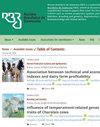饲喂不同饲粮蛋白质水平的肉鸡母鸡生产性能、营养物质消化率及肌肉性能评价(38和46日龄)
IF 1.2
4区 农林科学
Q3 Agricultural and Biological Sciences
Revista Brasileira De Zootecnia-Brazilian Journal of Animal Science
Pub Date : 2022-01-01
DOI:10.37496/rbz5120210151
引用次数: 2
摘要
本试验采用完全随机设计,采用5个处理,6个重复,每个重复13只鸡,评估了2种蛋白质水平和配方类型对390只21 ~ 46日龄雌性肉仔鸡生产性能、营养物质代谢和肌病的影响。试验采用2个蛋白质水平(19.0和21.0%)的饲粮,饲粮中只使用市售成分,3个试验配方旨在保持影响营养性能的主要营养成分(淀粉、纤维、粗脂肪)相似,采用19.0% (19E)或21.0% (21E)粗蛋白质,第三个试验配方采用19.0%粗蛋白质,氨基酸水平与处理21P相似(19E+Aa)。我们研究了肉鸡生产性能、营养物质消化率、宏观肌肉评价和组织学肌肉评价。生产性能和肌病评估设计为5 × 2因子方案,5种饲料× 2个年龄(38或46日龄)。19P处理的饲料转化率最差。饮食和年龄对肌病都没有影响,然而,年龄越大的屠宰年龄增加了显微镜下病变的强度。应避免饲粮中添加19P,增加饲粮中脂质含量可提高营养利用率,从而提高生产性能。本文章由计算机程序翻译,如有差异,请以英文原文为准。
Performance, nutrient digestibility, and muscular evaluation of female broiler chickens fed different dietary protein levels and slaughtered at 38 or 46 days
- This study evaluated the effects of two protein levels and types of formulation on performance, nutrient metabolization, and myopathies of 390 female broilers from 21 to 46 days old distributed in a completely randomized design, with five treatments and six replicates of 13 broilers each. Treatments were two levels of protein (19.0 and 21.0%) in diets using only commercially available ingredients and three experimental formulations designed to keep similar the main nutrients that could influence nutritional performance (starch, fiber, ether extract), using unusual ingredients, with 19.0% (19E) or 21.0% (21E) crude protein and the third with 19.0% crude protein with amino acid levels similar to treatment 21P (19E+Aa). We studied broiler performance, nutrient digestibility, macroscopic muscular evaluation, and histological muscular evaluation. The design for the performance and myopathy assessment was a 5 × 2 factorial scheme, five diets × two ages (38 or 46 days). The worst feed conversion ratio was observed for the 19P treatment. Neither diet nor age had an effect on myopathies, however, older slaughter age increased the intensity of microscopic lesions. The diet 19P should be avoided and increased inclusion of lipids in diets improves nutrient utilization and, consequently, performance.
求助全文
通过发布文献求助,成功后即可免费获取论文全文。
去求助
来源期刊
CiteScore
1.90
自引率
0.00%
发文量
25
审稿时长
8 weeks
期刊介绍:
The Revista Brasileira de Zootecnia (RBZ; Brazilian Journal of Animal Science) encompasses all fields of Animal Science Research. The RBZ publishes original scientific articles in the areas of Aquaculture, Biometeorology and Animal Welfare, Forage Crops and Grasslands, Animal and Forage Plants Breeding and Genetics, Animal Reproduction, Ruminant and Non-Ruminant Nutrition, and Animal Production Systems and Agribusiness.

 求助内容:
求助内容: 应助结果提醒方式:
应助结果提醒方式:


